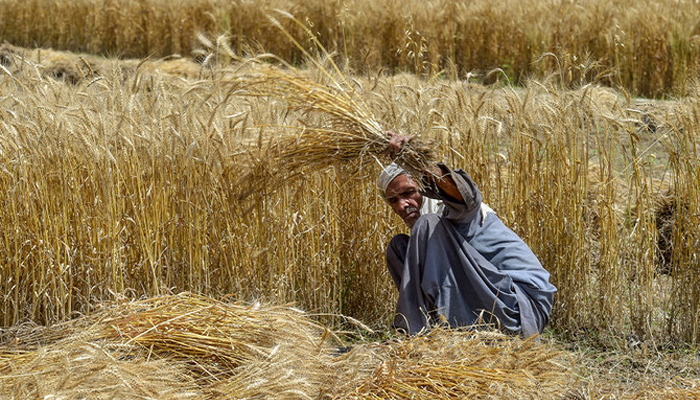Wheat sowing in Punjab beats target, sets stage for bumper harvest
LAHORE: Wheat sowing in Punjab, the country’s main breadbasket, has exceeded the official target and may reach a record level this year, as farmers are encouraged by high prices and timely rains, officials and farmers said on Tuesday.
According to the provincial agriculture department, wheat sowing has been completed on 16 million acres of land in Punjab so far, surpassing the official target of 15.8 million acres for the 2023-24 crop season. Sowing is still continuing in some areas.
The Punjab Agriculture Department has advised farmers in irrigated areas to cultivate approved varieties of wheat seeds within the stipulated time, by the second week of December at the latest. If the current trend sustains for the next fortnight or so, the area under wheat cultivation may reach a record level not seen since 2015-16.
The main factor behind the rising interest among farmers is the almost doubling of their selling price in recent years. The open market rate of wheat ranged between Rs 2,000 per maund (40 kg) and around Rs 4,200 in the open market in the last three years, driven by strong wheat minimum support prices (MSP) that have increased from Rs 2,200 per maund to Rs 4,000 since 2021-22.
For reference, the previous doubling of market rates and wheat support price occurred during 2008-09 to 2020-21, from Rs 950 per maund to Rs 1,800.
The greater area under wheat cultivation is certainly a good omen for the country's food security. Sowing within the optimal period is another positive sign, setting the stage for harvesting yet another good crop in the province.
According to official estimates, close to 94 percent of wheat sowing was completed by the end of November despite some challenges arising from the late launch of sugarcane crushing by millers.
Keeping these two encouraging trends in view, Punjab is optimistic about reaching its highly optimistic production target of 25.6 million tons for the province.
However, the main challenge in this regard will be the artificial shortage and high price of fertilizers. A good crop cannot be produced without applying chemical fertilizers. Therefore, extra efforts are needed to ensure the availability of urea and DAP fertilizers to farmers at official prices.
As far as providing nutrients to the crop is concerned, some responsibility falls on fertilizer manufacturers to discipline their registered dealers. This will keep supplies smooth and prevent them from engaging in black-marketing of urea. There should be a centralized helpline in the province where farmers can lodge complaints about non-availability or high-priced fertilizers.
Another challenge will be facing climate change-related stresses in March and at a later stage of harvesting. If the temperature remains within the range of 30-32 degrees Celsius during the month of March, it would be ideal for providing maximum time for plant growth before maturity.
Rainfall at the harvesting stage can play havoc with the yield. While canal supplies are said to be essentially available for the plantation, the quantum and timing of rains will play a major role in determining the size of the crop.
It is important to note that wheat is the most important food grain in the country and is grown on the largest area compared to all other crops. Therefore, the importance of cultivating it within the stipulated time is immense. Wheat must be sown at the optimum time, as delayed sowing causes a gradual decline in its yield.
-
 OpenAI And ServiceNow Team Up To Embed ChatGPT In Business Workflows
OpenAI And ServiceNow Team Up To Embed ChatGPT In Business Workflows -
 Johnny Depp Prepares For His Massive Comeback After Years Of Struggle
Johnny Depp Prepares For His Massive Comeback After Years Of Struggle -
 Meghan Markle Is Ready To Put A Cork In It All By Giving Prince Harry Baby No. 3: ‘She Wants A Break’
Meghan Markle Is Ready To Put A Cork In It All By Giving Prince Harry Baby No. 3: ‘She Wants A Break’ -
 Billie Eilish Speaks Out Against Authority: 'It's Very Strange'
Billie Eilish Speaks Out Against Authority: 'It's Very Strange' -
 'Greenland Will Stay Greenland', Former Trump Adviser Hints At New Twist
'Greenland Will Stay Greenland', Former Trump Adviser Hints At New Twist -
 Brooklyn Beckham's Wedding Dance With Mom Victoria Sparks Hilarious Memes
Brooklyn Beckham's Wedding Dance With Mom Victoria Sparks Hilarious Memes -
 King Charles' Latest Photos A Statement On His Health?
King Charles' Latest Photos A Statement On His Health? -
 Tom Cruise's Biggest Dream Crushed By The President?
Tom Cruise's Biggest Dream Crushed By The President? -
 King Charles, Queen Camilla Send Message To King Of Spain After Train Crash
King Charles, Queen Camilla Send Message To King Of Spain After Train Crash -
 'We Believe Brooklyn': David Beckham Trolled After Son's Statement
'We Believe Brooklyn': David Beckham Trolled After Son's Statement -
 Microsoft CEO Says AI Must Deliver Real World Impact To Survive
Microsoft CEO Says AI Must Deliver Real World Impact To Survive -
 Stranger Knocks, Then Opens Fire On Indiana Judge And Wife
Stranger Knocks, Then Opens Fire On Indiana Judge And Wife -
 Priscilla Presley's Derogatory Remarks On Late Daughter Lisa Marie Reignite Controversy
Priscilla Presley's Derogatory Remarks On Late Daughter Lisa Marie Reignite Controversy -
 Japan Unveils Anti-ship Missile With ‘barrel-roll’ Evasion To Outsmart Defenses
Japan Unveils Anti-ship Missile With ‘barrel-roll’ Evasion To Outsmart Defenses -
 How Brooklyn Beckham 'mentor' Prince Harry Inspiring Him To Speak Against Family?
How Brooklyn Beckham 'mentor' Prince Harry Inspiring Him To Speak Against Family? -
 Zac Efron, Kenny Ortega Revisit 'High School Musical' After 2 Decades
Zac Efron, Kenny Ortega Revisit 'High School Musical' After 2 Decades




